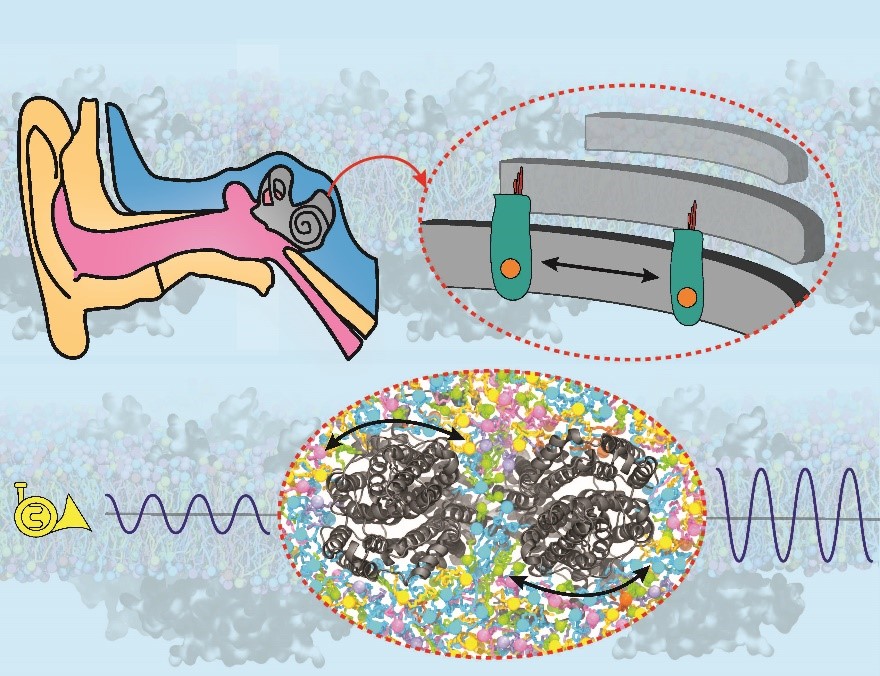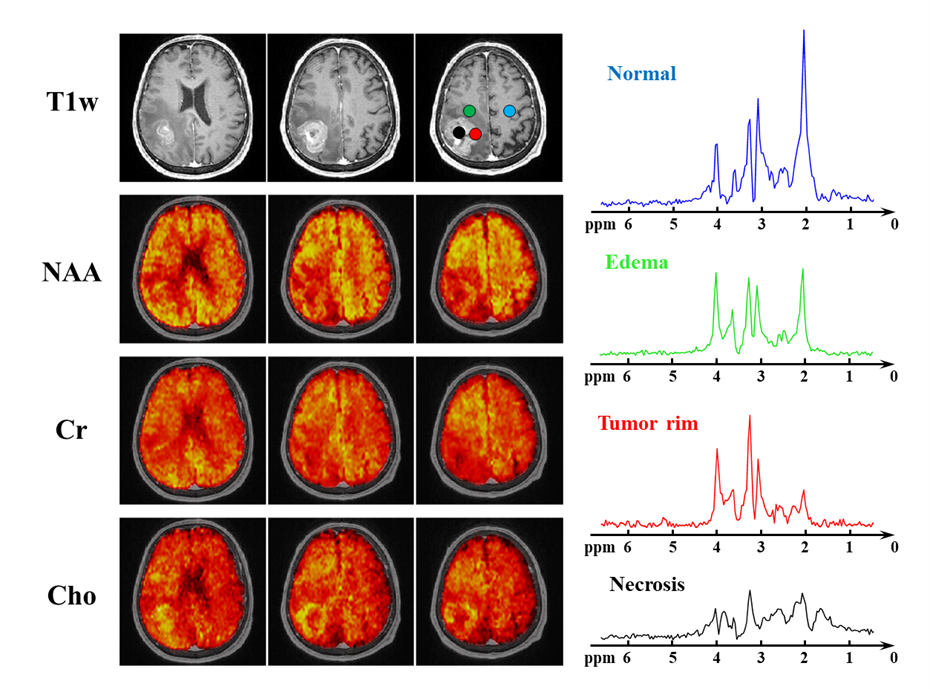Article
Three graduate students will present their research at the next Beckman Graduate Student Seminar: Sepehr Dehghani-Ghahnaviyeh, the Center for Biophysics and Quantitative Biology; Amanda East, chemistry; and Rong "Ronny" Guo, electrical and computer engineering.
The event takes place Wednesday, Oct. 13 at noon. Register to attend on Zoom.
 Prestin, the electromotive protein found in outer hair cells, is responsible for sound amplification within the hearing system.
Prestin, the electromotive protein found in outer hair cells, is responsible for sound amplification within the hearing system.Molecular mechanism of sound amplification in mammalian hearing system
Sepehr Dehghani-Ghahnaviyeh, the Center for Biophysics and Quantitative Biology
Prestin, the electromotive protein found in outer hair cells, is responsible for sound amplification within the hearing system. Prestin transits between an expanded and a contracted state in response to membrane potential shifts, resulting in alteration of the surface area in OHCs. Although prestin was discovered decades ago, its molecular mechanism to control surface area in OHCs remained elusive until recently. The first atomic-resolution structures of prestin allowed for molecular exploration of its mechanism. To provide insight into prestin’s function, we employed molecular dynamics simulations of the protein in native lipid bilayers. The simulations reveal that prestin substantially twists and curves membrane. To directly study the change in the membrane cross-sectional area associated with conformational transition between the contracted and expanded states, prestin’s structural transitions were induced using non-equilibrium MD simulations, observing a membrane area changes around 3-4%, in agreement with experimental studies. To investigate the collective effect of many prestin copies on the surface of OHCs, we simulated multiple copies of prestin in a lipid environment. The systems with all prestins in either contracted or expanded conformations exhibit distinct membrane curvature. The membrane bending energy calculation suggests that prestins favor specific, relative orientations in each conformation. Overall, our simulations suggest that both prestin conformational changes and prestin-prestin membrane-mediated interactions can contribute to sound amplification in the hearing system.
Biography
Sepehr Dehghani-Ghahnaviyeh is a Ph.D. candidate in computational biophysics under the direction of Professor Emad Tajkhorshid. His research interests lie in using large scale simulations and machine learning to study conformational changes of proteins and lipid-protein interactions. Dehghani-Ghahnaviyeh holds a bachelor’s degree in mechanical engineering from Iran University of Science and Technology and a master’s degree in mechanical engineering from Sharif University of Technology.
Development of a NIR-II photoacoustic probe for deep tissue sensing of nitric oxide
Amanda East, chemistry
 Photoacoustic imaging is a "light-in, sound-out" technique.Photoacoustic imaging is a “light-in, sound-out” technique that has gained significant traction within the biomedical imaging field. The majority of PA agents have been designed to absorb near-infrared (NIR)-I light (650-900 nm) where endogenous biomolecules (e.g. hemoglobin, deoxyhemoglobin, and melanin) exhibit significant background interference. Red-shifting to the NIR-II range (950-1100 nm) results in an improved signal to noise ratio as absorbance by tissue is negligible. To develop an optimized NIR-II probe for nitric oxide (NO), we employed a two-phase tuning approach. First, we identified a reactive and selective aniline-based trigger using physical organic principles. Then, with the trigger in hand, we screened a panel of NIR-II dye platforms to identify ones with optimal PA properties. With the optimized NIR-II probe for NO (APNO-1080) in hand, we compared APNO-1080 with its NIR-I congener and found that it was 17.7-fold more sensitive. We then performed PA imaging in an orthotopic breast cancer model and heterotopic lung cancer model, and we found that relative to the control mice, the normalized PA turn-on response was 1.30 ± 0.12 and 1.65 ± 0.07, respectively.
Photoacoustic imaging is a "light-in, sound-out" technique.Photoacoustic imaging is a “light-in, sound-out” technique that has gained significant traction within the biomedical imaging field. The majority of PA agents have been designed to absorb near-infrared (NIR)-I light (650-900 nm) where endogenous biomolecules (e.g. hemoglobin, deoxyhemoglobin, and melanin) exhibit significant background interference. Red-shifting to the NIR-II range (950-1100 nm) results in an improved signal to noise ratio as absorbance by tissue is negligible. To develop an optimized NIR-II probe for nitric oxide (NO), we employed a two-phase tuning approach. First, we identified a reactive and selective aniline-based trigger using physical organic principles. Then, with the trigger in hand, we screened a panel of NIR-II dye platforms to identify ones with optimal PA properties. With the optimized NIR-II probe for NO (APNO-1080) in hand, we compared APNO-1080 with its NIR-I congener and found that it was 17.7-fold more sensitive. We then performed PA imaging in an orthotopic breast cancer model and heterotopic lung cancer model, and we found that relative to the control mice, the normalized PA turn-on response was 1.30 ± 0.12 and 1.65 ± 0.07, respectively.
Biography
Amanda East is a Ph.D. candidate in chemistry under the direction of Jefferson Chan. Her research interests lie in developing and synthesizing new chemical probes for cancer detection. She received her undergraduate degree in chemistry from DePaul University. Among several other awards, East has received the Beckman Institute Graduate Fellowship and the DuPont Science and Engineering Fellowship.
High-resolution metabolic imaging of the brain
Rong "Ronny" Guo, electrical and computer engineering
 Magnetic resonance spectroscopic imaging has long been recognized a potentially powerful tool for noninvasive, label-free imaging of brain metabolites and neurotransmitters.
Magnetic resonance spectroscopic imaging has long been recognized a potentially powerful tool for noninvasive, label-free imaging of brain metabolites and neurotransmitters.Magnetic resonance spectroscopic imaging has long been recognized a potentially powerful tool for noninvasive, label-free imaging of brain metabolites and neurotransmitters. However, MRSI, after many years of development, still has rather limited practical applications because of several long-standing technical barriers, such as poor spatial resolution, limited spatial coverage, and long scan time. This talk will report our recent advances in addressing these problems using a new technology known as SPICE. SPICE effectively integrates efficient acquisition with machine learning-based data processing to enable rapid high-resolution MRSI. In this talk, I’ll share our recent experimental results to demonstrate the unprecedented capability of SPICE and its great potential for clinical applications.
Biography
Rong "Ronny" Guo is a Ph.D. candidate in electrical and computer engineering under the direction of Zhi-Pei Liang. He received his undergraduate degree in engineering physics from Tsinghua University and a master’s degree in electrical and computer engineering at University of Illinois Urbana-Champaign. Guo has received the Beckman Institute Graduate Fellowship, the Shun Lien Memorial Award, and the Knight Fellowship.
Beckman Institute for Advanced Science and Technology